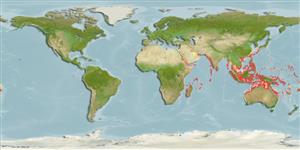Common names from other countries
Environment: milieu / climate zone / depth range / distribution range
Ekologi
Berasosiasi dengan karang; kisaran kedalaman 0 - 48 m (Ref. 101963). Tropical; 36°N - 34°S, 27°E - 176°W (Ref. 846)
Indo-Pacific. Tropical to subtropical.
Length at first maturity / Size / Weight / umur
Maturity: Lm ? range ? - ? cm
Colonies are massive or are unifacial or bifacial thick plates which may be tiered in large colonies. Corallites: mostly immersed. Coenosteum: covered with papillae and/or tuberculae. Pale brown or blue; with blue or white margins (Ref. 846).
Mostly found in upper reef slopes (Ref. 846) but also grows on deeper reef areas (Ref. 98471).
Life cycle and mating behavior
Kematangan | Reproduksi, perkembang biakan | Pemijahan | telur-telur | Fecundity | Larva
Hermaphroditic (Ref. 113712). Mature gametes are shed into the coelenteron and spawned through the mouth. Life cycle: The zygote develops into a planktonic planula larva. Metamorphosis begins with early morphogenesis of tentacles, septa and pharynx before larval settlement on the aboral end (Ref. 833).
rujukan utama
Acuan | Koordinator | mitra
Veron, J.E.N. 2000. (Ref. 846)
Status IUCN Red List (Ref. 130435)
status CITES (Ref. 108899)
Not Evaluated
penggunaan manusia
| FishSource |
Alat, peralatan
informasi lanjut
Umur / SaizPertumbuhanpanjang-beratpanjang-panjangMorfologiLarvaKelimpahan
Sumber internet
Estimates based on models
Preferred temperature
(Ref.
115969): 24.7 - 29.1, mean 28.1 (based on 1470 cells).
kategori harga
Unknown.
